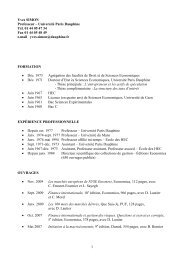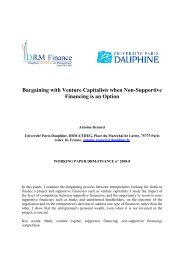Corporate governance and earnings management ... - CEREG
Corporate governance and earnings management ... - CEREG
Corporate governance and earnings management ... - CEREG
You also want an ePaper? Increase the reach of your titles
YUMPU automatically turns print PDFs into web optimized ePapers that Google loves.
eserves, turned out to be less than “optimal” despite its merits, because it eliminated reserves<br />
that were useful for dividend distribution. This appears to be confirmed by the opinion of one<br />
of the leading professional actors of the time, the audit firm Arthur Andersen. One of its bestknown<br />
partners declared quite unambiguously that pooling of interests, a method that was to<br />
develop subsequently (see below) was invented for two reasons:<br />
- to prevent goodwill appearing;<br />
- to make it possible to “maintain the earned surplus” (Spacek, 1973).<br />
The second reason, mentioned by Spacek, but also by Kripke (1961, p. 1029, note 3), is<br />
particularly interesting, because it shows that the write-off approach is not optimal given its<br />
sudden impact on retained <strong>earnings</strong>.<br />
Another problem for the write-off solution was that it reduced the financial surface:<br />
“killing” of the balance sheet at a time when it was more <strong>and</strong> more important to show the<br />
creation of value on the stock markets (see below) was not so good. Some companies, taking<br />
this view, sought another “acceptable” if not better approach.<br />
b) The rise to dominance of the dynamic approach<br />
The move towards the dynamic approach happened slowly. It probably began in the 1930s,<br />
a period of serious economic depression when businesses tried to reassure shareholders by<br />
providing a “smoothed” (to apply a modern term) presentation of income. This is what is<br />
apparently suggested by the Correspondence between the Special Committee on Co-operation<br />
with Stock Exchanges of the American Institute of Accountants <strong>and</strong> the Committee on Stock<br />
List of the New York Stock Exchange: “Some method, however, has to be found by which the<br />
proportion of a given expenditure to be charged against the operations in a year, <strong>and</strong> the<br />
proportion to be carried forward, may be determined; otherwise, it would be wholly<br />
impossible to present an annual income statement” (Correspondence, 1932-1934, p. 6, quoted<br />
in Catlett & Olson, 1968, p. 32). But in a context of economic crisis with conservative<br />
approaches still very strong at the time (Kripke, 1961, p. 1032), it was too early for full<br />
44



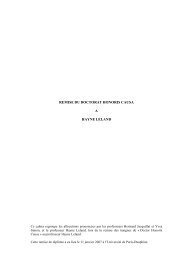

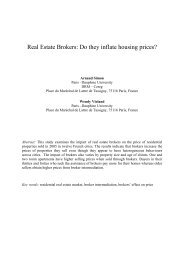
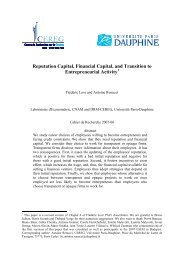

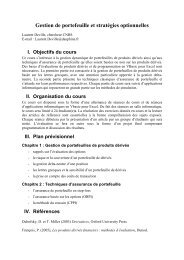



![& 6 ] ^ F ]^ - CEREG - Université Paris-Dauphine](https://img.yumpu.com/33326502/1/184x260/-6-f-cereg-universitac-paris-dauphine.jpg?quality=85)

